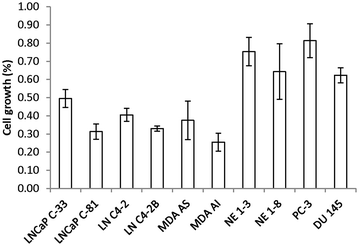Cellular prostatic acid phosphatase (cPAcP) serves as a useful biomarker of histone deacetylase (HDAC) inhibitors in prostate cancer cell growth suppression
- PMID: 26185616
- PMCID: PMC4504398
- DOI: 10.1186/s13578-015-0033-y
Cellular prostatic acid phosphatase (cPAcP) serves as a useful biomarker of histone deacetylase (HDAC) inhibitors in prostate cancer cell growth suppression
Abstract
Background: Prostate cancer (PCa) is the most commonly diagnosed solid tumor and the second leading cancer death in the United States, and also one of the major cancer-related deaths in Chinese. Androgen deprivation therapy (ADT) is the first line treatment for metastatic PCa. PCa ultimately relapses with subsequent ADT treatment failure and becomes castrate-resistant (CR). It is important to develop effective therapies with a surrogate marker towards CR PCa.
Method: Histone deacetylase (HDAC) inhibitors were examined to determine their effects in androgen receptor (AR)/cellular prostatic acid phosphatase (cPAcP)-positive PCa cells, including LNCaP C-33, C-81, C4-2 and C4-2B and MDA PCa2b androgen-sensitive and androgen-independent cells, and AR/cPAcP-negative PCa cells, including PC-3 and DU 145 cells. Cell growth was determined by cell number counting. Western blot analyses were carried out to determine AR, cPAcP and PSA protein levels.
Results: cPAcP protein level was increased by HDAC inhibitor treatment. Valproic acid, a HDAC inhibitor, suppressed the growth of AR/cPAcP-positive PCa cells by over 50% in steroid-reduced conditions, higher than on AR/cPAcP-negative PCa cells. Further, HDAC inhibitor pretreatments increased androgen responsiveness as demonstrated by PSA protein level quantitation.
Conclusion: Our results clearly demonstrate that HDAC inhibitors can induce cPAcP protein level, increase androgen responsiveness, and exhibit higher inhibitory activities on AR/cPAcP-positive PCa cells than on AR/cPAcP-negative PCa cells. Upon HDAC inhibitor pretreatment, PSA level was greatly elevated by androgens. This data indicates the potential clinical importance of cPAcP serving as a useful biomarker in the identification of PCa patient sub-population suitable for HDAC inhibitor treatment.
Keywords: Biomarker; Cellular prostatic acid phosphatase; Histone deacetylase inhibitor; Prostate cancer.
Figures




Similar articles
-
Histone deacetylase inhibitor valproic acid suppresses the growth and increases the androgen responsiveness of prostate cancer cells.Cancer Lett. 2011 Dec 8;311(2):177-86. doi: 10.1016/j.canlet.2011.07.015. Epub 2011 Jul 22. Cancer Lett. 2011. PMID: 21862211 Free PMC article.
-
ErbB-2 signaling plays a critical role in regulating androgen-sensitive and castration-resistant androgen receptor-positive prostate cancer cells.Cell Signal. 2015 Nov;27(11):2261-71. doi: 10.1016/j.cellsig.2015.08.002. Epub 2015 Aug 6. Cell Signal. 2015. PMID: 26257301 Free PMC article.
-
Human prostatic acid phosphatase, an authentic tyrosine phosphatase, dephosphorylates ErbB-2 and regulates prostate cancer cell growth.J Biol Chem. 2010 Jul 30;285(31):23598-606. doi: 10.1074/jbc.M109.098301. Epub 2010 May 24. J Biol Chem. 2010. PMID: 20498373 Free PMC article.
-
Cellular prostatic acid phosphatase: a protein tyrosine phosphatase involved in androgen-independent proliferation of prostate cancer.Endocr Relat Cancer. 2005 Dec;12(4):805-22. doi: 10.1677/erc.1.00950. Endocr Relat Cancer. 2005. PMID: 16322323 Review.
-
Androgen receptors in hormone-dependent and castration-resistant prostate cancer.Pharmacol Ther. 2013 Dec;140(3):223-38. doi: 10.1016/j.pharmthera.2013.07.003. Epub 2013 Jul 13. Pharmacol Ther. 2013. PMID: 23859952 Review.
Cited by
-
Epigenetic therapy in urologic cancers: an update on clinical trials.Oncotarget. 2017 Feb 14;8(7):12484-12500. doi: 10.18632/oncotarget.14226. Oncotarget. 2017. PMID: 28036257 Free PMC article. Review.
-
ErbB-2 signaling in advanced prostate cancer progression and potential therapy.Endocr Relat Cancer. 2019 Apr 1;26(4):R195-R209. doi: 10.1530/ERC-19-0009. Endocr Relat Cancer. 2019. PMID: 31294537 Free PMC article. Review.
-
Novel PAP-targeted CAR-T therapy enhances antitumor efficacy through CoupledCAR approach.J Immunother Cancer. 2025 May 31;13(5):e011238. doi: 10.1136/jitc-2024-011238. J Immunother Cancer. 2025. PMID: 40449956 Free PMC article.
-
Current Stem Cell Biomarkers and Their Functional Mechanisms in Prostate Cancer.Int J Mol Sci. 2016 Jul 19;17(7):1163. doi: 10.3390/ijms17071163. Int J Mol Sci. 2016. PMID: 27447616 Free PMC article. Review.
-
Cellular analysis of the action of epigenetic drugs and probes.Epigenetics. 2017 May 4;12(5):308-322. doi: 10.1080/15592294.2016.1274472. Epub 2017 Jan 10. Epigenetics. 2017. PMID: 28071961 Free PMC article. Review.
References
-
- Zhang L, Davis JS, Zelivianski S, Lin FF, Schutte R, Davis TL, et al. Suppression of ErbB-2 in androgen-independent human prostate cancer cells enhances cytotoxic effect by gemcitabine in an androgen-reduced environment. Cancer Lett. 2009;285:58–65. doi: 10.1016/j.canlet.2009.04.041. - DOI - PMC - PubMed
Grants and funding
LinkOut - more resources
Full Text Sources
Other Literature Sources
Research Materials
Miscellaneous

